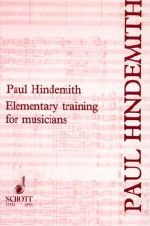
| Printed: | 1946 | Author: | Paul Hindemith |
| Publisher: | European American Music Distribution Corporation | ISBN: | 0901938165 |
| Suppliers: | 






|
Paperback (June 1946), usually ships within 4-6 weeks.
Amazon Customer Review
Reviewer: bassplayerwriterhuman from New York, NY
I'm taking music lessons - one hour a week. We started on this book a little over a year ago, and I think I'm on page 14. In that year, I feel that my eyes have opened up finally (or more literally, ears). My sense of rhythm, harmony, melody, and pitch, all have improved to probably double if not triple where I was last year.
I'm nowhere near god-like status, and not quite a professional level musician (though I imagine that's not far off if I keep working, which I will), but then - I'm only on page 14.
One caveat, with this, as with all music books, it helps tremendously to have a teacher to point out your mistakes & do the exercises with you. My music teacher keeps telling me that a lot of teachers don't do this method because *they* have to work too with this book. They can't just sit back & watch you read the notes, nor can they give you hour-long dissertations on whatever theory they think is relevant. They have to listen, work, and there are dictations that are meant to be done with this book as well where your teacher sings or plays or taps a part & you write it down or repeat it.
I work hard every week with this book, and so does my music teacher. If I master one exercise in that time great, if I breeze though 5 (yeah right!) fine - I know I'm getting the skills I need, and Hindenmith doesn't skimp, so I know I'm getting *all* the skills I need.
The book is broken down (if I remember correctly) into 3 repeated parts - action, time and action-in-time. Or, pitch, rhythm, and pitch with rhythm. A fourth part is the dictations.
The exercises are also inherently musical, not mindless. My teacher is constantly pointing out "that's an important interval for you to know - see how he's making you sing it?" or "that's an important rhythm for you to know..."
I wouldn't reccomend this book to someone who thinks they can sit at home with a book & "get it". Though the excercises can, technically be done alone (the dictations can't), how can you HEAR something your skill level doesn't allow? How can you practice singing intervals if you yourself don't hear them? Who will bring you to the next level?
Someone needs to write a computer program based on this book - tap the space bar in the appropriate way, sing into the microphone, etc. While it couldn't replace a teacher, it could give you something to work with between lessons.

